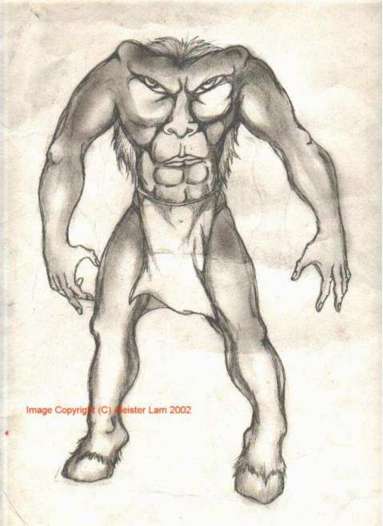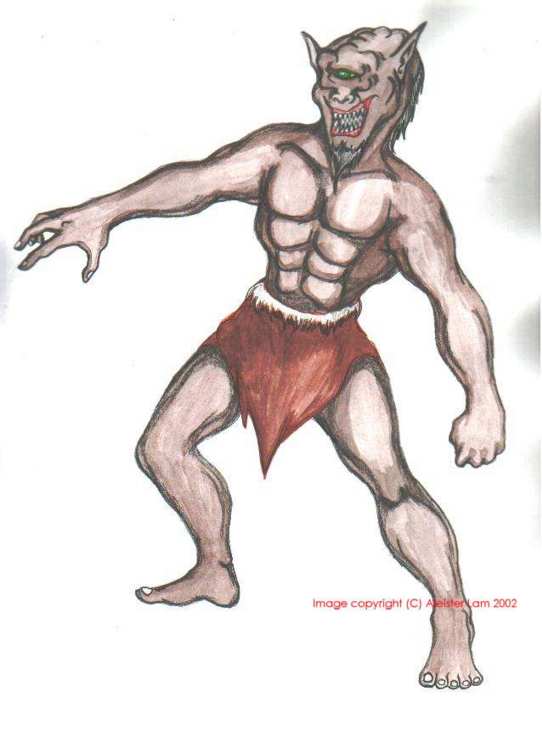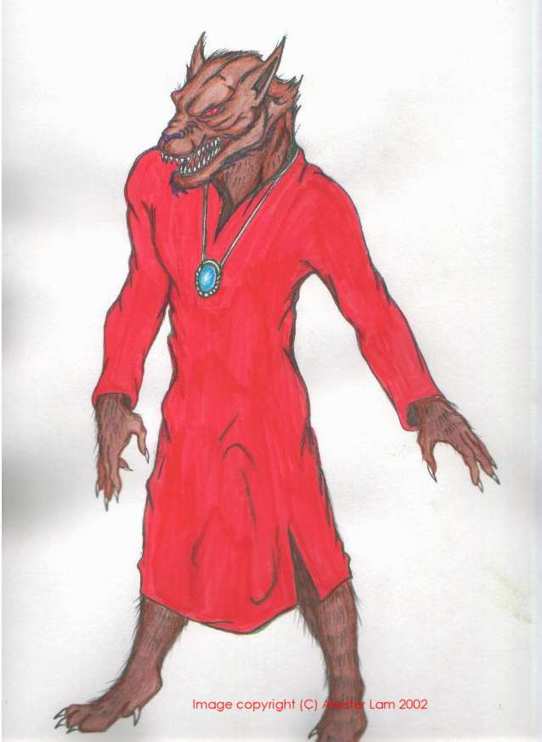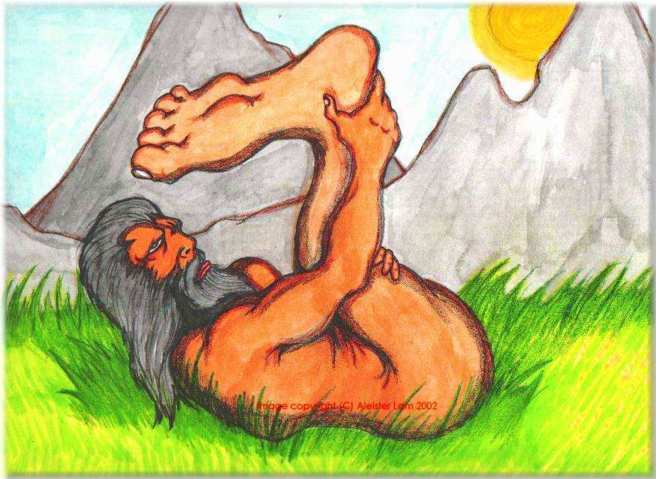|
|
|
|
All Original Images appearing in this Gallery : Copyright(C) Aleister Lam 2002 |
|
 |
The Blemmyae Before Christopher Columbus ventured out to the brave New World to discover the untamed lands, there was already an influx of sensationalised stories about fabulous beasts and monstrous race that play a role on the European consciousness of the unknown. Therefore, Columbus was already prepared for expectations and images of the unknown that he might probably encounter in these New World. Armed with references from previous travellers like Isidore of Seville and Pierre d Ailly's Imago Mundi, which is a sort of fabulous list of the monstrous race, Columbus set out to affirmed the existence of these grotesque images that so fascinates him. His travel document recounts a strange monstrosity whose eyes, nose and mouth are located below the shoulders. These monstrous creatures were collectively known as Blemmyae. The Blemmye was presumed to be frightening because his facial feature is found on his chest and is a scary sight when a Blemmye is encountered at night; for it is easily mistaken for a headless figure or ghost. Long before Washington Irving introduced his story of a headless Hessian Trooper that was unable to rest in his grave in the 'Legend of Sleepy Hollow', records and even depiction of a headless race has already existed. Even during the reign of the Pharaohs, it is said that their god Seth is also identified with a sort of headless demon whose eyes are placed in the shoulders, the Akephalos. They are a more cultured race as compared to the Sciapodae or Cynocephali as they have been known to cultivate crops and plant fruit trees. Though they will take up arms and go to war if there were any aggressors imposing on them; but generally they are good farmers and hunters. Medieval maps like the Hereford Mappamundi also depict and even identify the location of these Monstrous race that dwells along the extreme edges of the world. Strangely, the Blemmyae seems to have survived through to modern times but its just that it had probably evolved or mutated into a more alien-like headless entity with a hairy body and a pair of winged appendages that was widely publicised in the media when it was seen in West of Virginia. This headless winged humanoid came to be known as the Mothman. It is also spell as Blemye(singular) or Blemyae. In this picture, rather than giving the Blemye a normal set of human feet, I've decided to use a more personal approach by giving it a hooved feet. |
|
|
|
 |
The Arimaspi In Greek mythology like Homer's Odyssey and Hesoid's Theogany, it described a race of one-eye being known as the Cyclops, but the East also have its fair share of beliefs on these monstrous beings. The Greek Historian, Pliny mentioned in his writings that there's these race of beings with a single eye only, right in the middle of their fore-head known as the Arimaspi and that they lived in the far Northern Regions of the earth, his collections of materials on the Arimaspi in the East also included their habit of collecting golds and precious stones. The Arimaspi are barbaric flesh eaters and would usually hunt alone rather than in groups, they would usually clobbered their prey to death with a club then feast on them raw. They are very selfish and greedy creature that will not share their kill or loot with anyone else, that's why they are not very successful hunter and the later generations of Arimaspi turned to shepharding and rearing sheeps. The historical traveller Sir John Mandeville chronicled in his travel journal the Arimaspi of India are thieves that steal golds and gemstones from the griffins, therefore they are constantly at war with their neighbours who guarded these treasures with their life. |
|
|
|
 |
Cynocephali In my picture on The Lord of the Werewolves, I mentioned of a race of monsters known as the Cynocephali; these breed of creatures were widely reported in the Middle Ages by historians like Pliny,the Elder, Sir John Mandeville and Saint Isidore of Seville. They were a race of dog-headed creatures that are extremely smart and brutal and their anthropophagous tendency makes them a menace to man-kind. Even the Venetian traveller Marco Polo writes that these dog-headed tribes were found on the island of Andaman, about a thousand miles East of Ceylon which was then known as Taprobana in medieval maps. In the Liber Monstrorum, an eight-century text on monsters, describe the Cynocephali as living off the edges of the civilised world who actually communicated by barking at each other which obviously betrays them as uncivilised beasts even though they were able to walk up-right. Interestingly, sources revealed these dog-headed race retained an unusual position in Christian teachings and writings. Werewolves were commonly perceived as the descendants of Cain or a monstrocity that is a result of co-habiting with the devil. It is said that Christianity and their teachings had pacify these brutal beasts and allowed them to control their savagery and even though in very rare case allowed inter-marriage between humans and the Cynocephali. The offsprings that resulted in this union were very much human except for the fact that they were also beastial from within and when they are unable to oppressed this bestial nature or have forsaken their believes in Christianity and get tempted by the demon within; the animal hidden inside them burst forth tranforming them into a monster. Legend has it that Saint Christopher, the patron saint of the travellers and sea-farers was also Cynocephali-convert. Born a pagen dog-head known as Reprobus; he oppose savagery and hated the brutality committed by his race. He was overjoyed when a accidental acquaintance with a prient introduced him to Christianity. He then forsaken his beastial nature by focusing and concentrating on this teachings and eventually he was able to pacify his Cynocephali nature. In Christian literature; that portion of St. Christopher being a Cynbocephali was silently removed; and over time it was slowly forgotten and people even dissociate the legends of werewolves from the Cynocephali. |
 |
Sciapodae or Monocoli When you first heard of the phrase, 'able to leap tall building in a single bounce' you'll probably think of Superman but I realised that in medieval times, this phrase is most suited to a race at the far corners of the world with this ability to leap at a long distance and would probably be as fast as a locomotive if it were to exist then, with just one foot. This strange race is known as the Sciapodae. Ctesias, the Greek historian described a monstrous race of men with only one foot, they are called Sciapodae which is Greek gord that means making a shadow with his foot. The Sciapodae lived right at the edge of India where the weather is very hot and the mid-day sun would scorched the earth; causing it to be as hot as a frying pan which is unbearable for humans to walk on. The Sciapodae have a thick and seasoned layer of protective skin at the base of their feet which enable them to leap around the heated ground without any footware needed. When relaxing, these Sciapods would lay on their backs and hold their foot above themselves acting as parasols shielding their body from the intense heat of the sun. The Sciapodae is the first of the series of pictures which I did on the monstrous race that probably existed in the far East along time ago, because many famous scholars and travellers from Pliny to Marco Polo mentioned their existence and even pin-point where they might be located in medieval maps like the Hereford Mappamundi. |